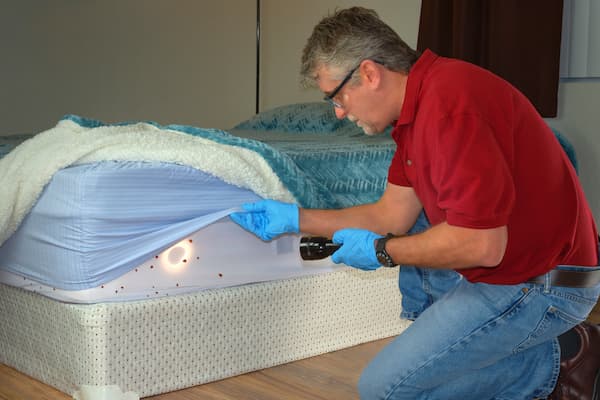Exploring the Science Behind Bed Pest Heat Treatments as a Lasting Insect Management Method
In the realm of parasite management, the quest for lasting and efficient remedies stays a consistent quest. One such technique that has gotten grip recently is making use of heat therapies to fight bed pest infestations. By using the science behind thermal death factors for these persistent bugs, heat treatments supply a promising option to typical chemical-based methods. The ins and outs of how warm properly eliminates bed bugs and the wider effects for lasting insect administration techniques make this a subject worth exploring even more.
Bed Bug Heat Treatment Process

Thermal Fatality Point for Bed Pests
Subjecting bed pests to raised temperatures past their thermal resistance variety is crucial for accomplishing effective elimination in heat therapy processes. The thermal fatality factor for bed bugs describes the temperature at which these bugs can not make it through. Research study indicates that bed insects begin to perish when subjected to temperature levels above 113 ° F(45 ° C) for a sustained duration. As the temperature boosts, so does the mortality price of bed bugs. At around 118 ° F(48 ° C ), bed bugs start to pass away rapidly, with a death price of nearly 99% within mins of direct exposure. This shows the sensitivity of bed insects to heats and highlights the effectiveness of warm therapies in eradicating invasions. By getting to and keeping temperature levels above the thermal fatality factor for bed bugs, pest administration specialists can make certain comprehensive elimination of bed insect populaces, consisting of hard-to-reach locations where chemical therapies might be less effective. Comprehending the thermal death point for bed bugs is necessary for applying effective heat treatment techniques and achieving sustainable insect administration results.
Benefits of Warmth Treatments
Having actually established the crucial thermal death factor for bed insects, it is vital to now check out the considerable benefits that warm treatments supply in successfully eliminating these resilient parasites. Heat therapies existing numerous crucial benefits when contrasted to conventional chemical approaches. Among the main benefits is that warm can pass through deep into holes and fractures where bed pests conceal, ensuring that also one of the most hard-to-reach areas are warmed to deadly temperature levels. This extensive strategy not only kills live bugs however also targets bed insect eggs, protecting against future invasions.
Moreover, warmth treatments are non-toxic and eco-friendly, making them a sustainable pest administration approach. Unlike chemical pesticides, warmth treatments do not leave harmful residues that can position risks to human health and wellness or the atmosphere. This element is specifically vital in delicate settings such as hospitals, schools, and suburbs where chemical use may not be desirable.
Furthermore, warm treatments have a high success rate in getting rid of bed insect invasions in a solitary therapy, minimizing the demand for several brows through and decreasing disturbance to passengers. This effectiveness not only saves time and money but likewise supplies comfort to those handling bed bug troubles.
Performance of Warm Treatment

Warm therapies have actually the included benefit of killing bed bug eggs, which are typically resistant to conventional chemical therapies. On the whole, the performance of warm treatments in eliminating bed insect invasions makes them a sustainable and trustworthy bug monitoring approach.
Lasting Parasite Monitoring Conveniences
Implementing sustainable parasite monitoring methods provides long-term benefits for both the environment and public wellness. By utilizing techniques such as heat therapies for parasite control, we can lower the reliance on hazardous chemical pesticides that can have unfavorable results on ecological communities and human wellness - bed bug heat treatment. Lasting bug administration strategies aid in protecting biodiversity by targeting specific parasites without hurting non-target organisms, consequently preserving a balanced ecological community
Moreover, sustainable bug management techniques add to the total health and wellness and health of the general public. By reducing direct exposure to harmful chemicals made use of in conventional parasite control techniques, warmth treatments provide a more secure alternative for bug management in property, commercial, and public areas. This decrease in chemical usage likewise aids in avoiding chemical residues from polluting air, soil, and water, protecting ecological high quality.
Verdict
In conclusion, pop over to this site bed insect warm therapies have been shown to be a lasting and efficient bug monitoring strategy. The thermal death factor for bed pests makes them at risk to heat treatments, which have various benefits over traditional chemical treatments. The efficiency of warm therapies in removing bed pest infestations while minimizing environmental effect highlights the possibility of this approach as a lasting solution for pest control.
The bed bug heat treatment process involves raising the temperature level within ravaged locations to a degree that properly removes bed pests and their eggs. By getting to and keeping temperature levels over the thermal death factor for bed pests, parasite monitoring specialists can make certain thorough removal of bed insect populaces, including hard-to-reach areas where chemical therapies may be less reliable. One of the main advantages is that heat can penetrate deep right into crevices and cracks where bed pests conceal, making sure that even the most hard-to-reach areas are heated to dangerous temperatures. Unlike chemical therapies that might leave behind resistant populations, warmth therapies provide a ecologically friendly and non-toxic remedy that can pass through deep into furniture, wall surfaces, and other hard-to-reach areas where bed pests hide.
The thermal fatality factor for bed insects makes them vulnerable to heat therapies, which have various benefits over standard chemical treatments.